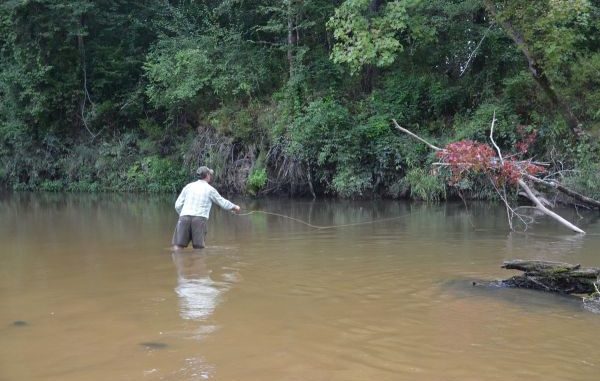
Thirty-one-year-old Jeshua “Jesh” Smith is a dedicated creek fisherman.
He grew up hunting deer and bream fishing. In high school he started bass fishing, first in farm ponds and later graduating to larger lakes.
But the lakes were crowded, something he didn’t like. Then his dad Danny bought three kayaks. The young man quickly discovered he liked not having to deal with maintenance, gas, oil, and trailer registration and licensing.
“Why not just have something that floats and a paddle?” Smith asked. “I kept one in the bed of my truck while I was in college. Because of the kayak, everybody at Louisiana Tech knew who I was.
“I started creek fishing on Toro Bayou south of Zwolle. I had never been fishing on a creek before. I called a buddy, Corey Stover, and talked him into going. It didn’t take me long and I had a spotted bass in the boat.
“We called them ‘redeyes’ or ‘Kentucky bass’ growing up. At the end of the trip, we each had 10 on a stringer.”
That taught him a lesson he never forgot.
“I realized that creeks were an untapped resource,” Smith said. “Because of the actual work involved, not many people are willing to do it. Boats have to be pulled over logs, and controlling them in the current isn’t easy.
“And you have to think three or four casts ahead of you. You can’t effectively fish this kind of fast-moving water unless you can read the water several casts ahead. Reading the water means knowing where the fish are going to be. You have to position the boat to make a good cast.”
At some point, Smith had worked out all the keys to success, and began looking to up the challenge.
“As hard as it is for some people, it finally got too easy for me,” he explained. “You just throw a little Zoom Baby Brush Hog and wham — pull them out right and left.
“I started fly fishing about five years ago because controlling the line and rod at the same time as the boat was more challenging.”
Smith makes about 20 float trips a year, many on streams other than the Ouiska Chitto.
Other creeks he deems good fishing are Bundick Creek (a favorite), the Calcasieu River, Ten Mile Creek and Six Mile Creek, the latter two of which are easier to wade than to float.
Parts of Bundick and Ouiska Chitto creeks lie in Kisatchie National Forest and are, therefore, accessible to the public.
Drakes Creek, a fair amount of which flows through Fort Polk and the Vernon Ranger District of Kisatchie, is wade-only.
Stretching his legs a bit, Smith also floats the Sabine River below Toledo Bend Reservoir and Anacoco Creek below Anacoco Lake.
Water level conditions are important for this type of fishing. “The most useful information that a creek fisherman can have,” Smith said, “is on the website waterdata.usgs.gov/la/nwis/rt. It gives data on water level and flow. For float-fishing, I want the water in the creek to be low, with a steady level — what I call a ‘flatliner.’
“Because sand moves, more than water levels can change rapidly in creeks. Deep holes can fill in or a log moving into a spot can cause scouring, which will create a deep hole.
“The more you fish a creek, the more you learn about the creek.”
His float trips offer solitude.
“I like creek fishing because the only people you see are the people with you, unless you are on a canoe run,” Smith said.
He prefers floating the more-traveled routes from October through March.
“I catch my best fish in November and December,” Smith said. “The problem is that very seldom do you catch the right weather.
“I fished Bundick Creek last year with 2 inches of snow on the creek’s banks.”
Creek fishing produces both spotted bass and largemouth bass, with spotted bass outnumbering their big-mouthed cousin by a ratio of 10 to 1. According to Smith, there is “no rhyme or reason” as to where which species is caught in a particular creek.